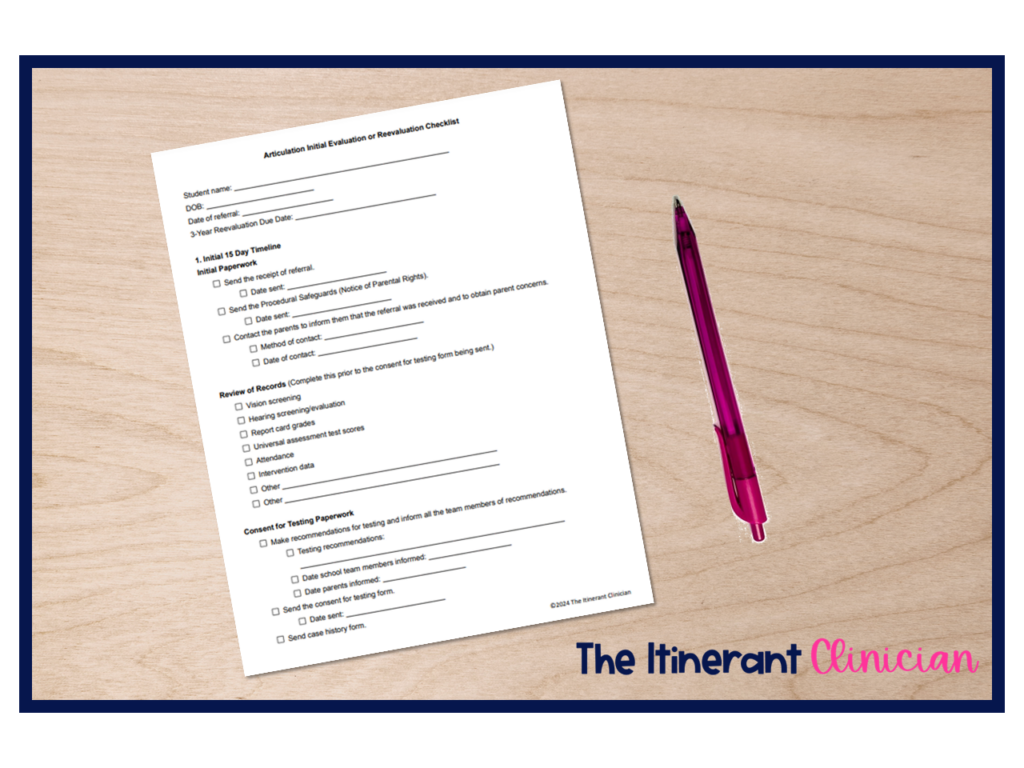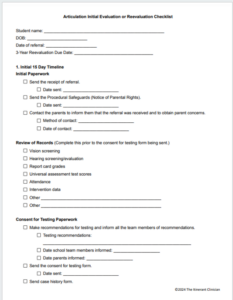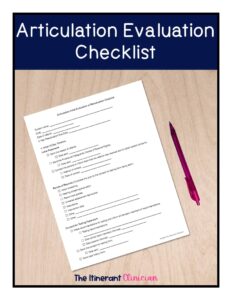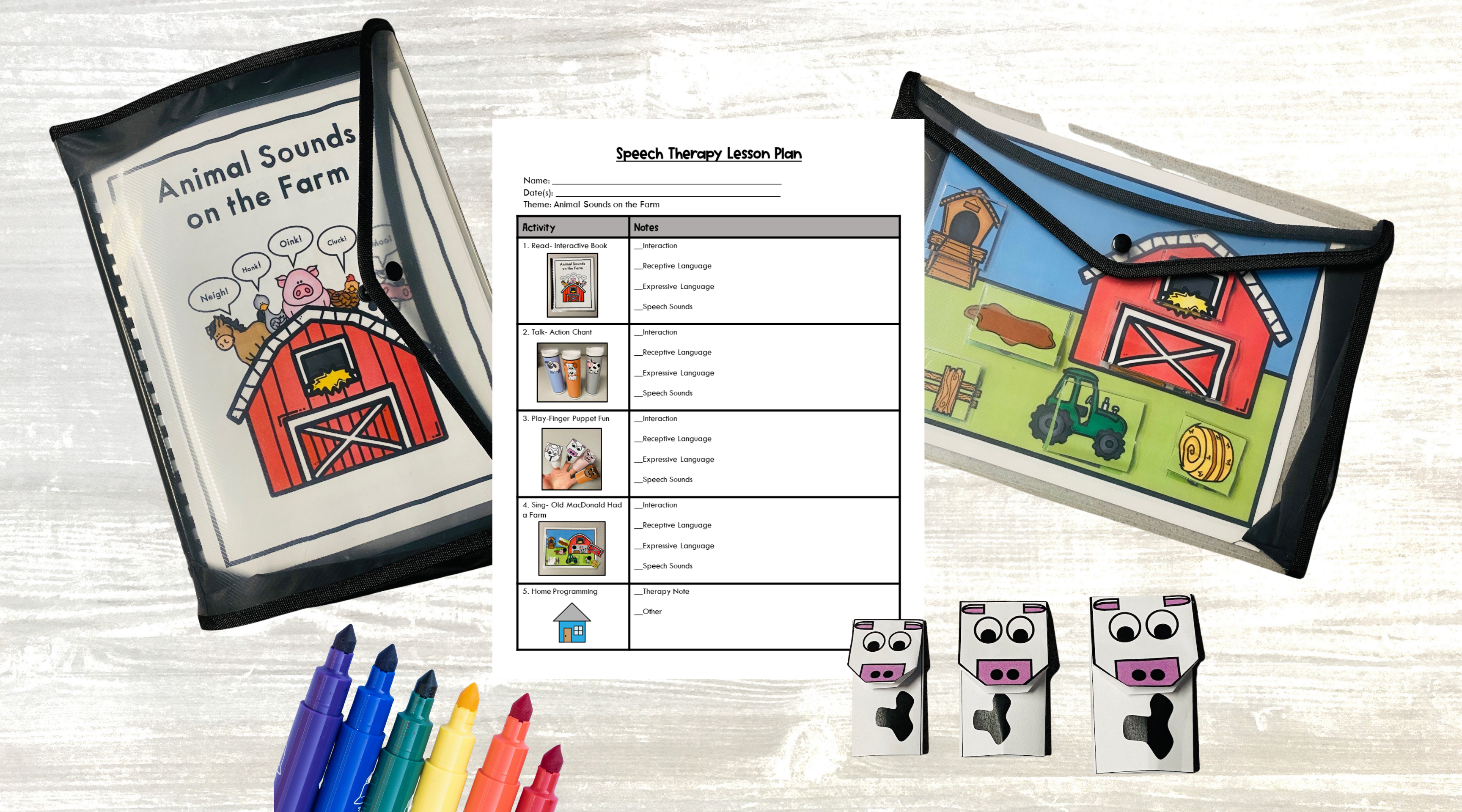Sharing is caring!
Hey there, SLP friend! Today we’re talking about something that’s always on our minds – speech therapy evaluations and those tricky timelines! cue dramatic music 😄 I know what you’re thinking: “Between therapy sessions, IEP meetings, and that mountain of paperwork on my desk, how am I supposed to fit in another speech therapy evaluation?” Don’t worry, we’re going to break this down together!
Speech Therapy Evaluation: Initial 15 Day Timeline*
*Most states use this 15-day timeline, but check with your state to confirm.
When a teacher, parent, or caregiver suspects that a child might have a disability requiring special education support, they can request a special education evaluation. This process is crucial for identifying whether the child qualifies for services and determining the specific support they need to thrive in school.
Here’s a clear breakdown of the key steps in the initial timeline:
- Request for Evaluation
The process begins when someone submits a request for evaluation. This request can come from a parent, teacher, or another school professional. It’s the first step in ensuring the child’s needs are properly assessed. - 15 Calendar Days to Respond
Once the school receives the evaluation request, they have 15 calendar days to respond. During this time, the evaluation team conducts a review of records to analyze existing information about the child. Based on this review, the team decides if an evaluation is necessary. If they determine that an evaluation is appropriate, they will develop a detailed evaluation plan that specifies the assessments and tests they intend to use. If the team determines that an evaluation is not needed, this is where the initial evaluation process stops. Fill out a form indicating this in your student management system and notify the parents. - Parental Consent
Before the testing can begin, the school must share the evaluation plan with the child’s parent(s) or guardian(s) and obtain their written consent. The school is required to send this consent form within the same 15-day timeline, ensuring the process moves forward without delay.
Do you need a way to keep track of all your timelines? Use this FREE Articulation Evaluation Checklist. Click on the picture to check out the evaluation checklist before downloading your free copy.
Who Should Be on My Evaluation Team for a Speech-Only Referral?
For a speech-only evaluation, the evaluation team must include the following required members. Additional team members may be included depending on the student’s specific needs.
- LEA Representative
This individual represents the Local Education Agency (LEA). In most cases, the LEA Representative is an administrator, but in some districts, this role can also be fulfilled by an SLP, depending on district policy. - Regular Education Teacher
This is typically the classroom teacher or daycare teacher. However, if the student is not enrolled in school or daycare, a teacher is not required on the team. - Special Education Teacher
For speech-only referrals, the SLP serves as the Special Education Teacher in the evaluation process. - Parents/Caregivers
Parents or caregivers are essential members of the evaluation team, providing valuable input and insight about the child’s needs.
How Do I Calculate the 15-Day Special Education Timeline?
The 15-day timeline applies to business days only. Accuracy is crucial when tracking these dates. To ensure precision, I recommend using a web-based business day calculator to confirm the correct deadlines.
How Do I Notify Parents That the Referral Has Been Received?
When you receive a referral, it’s important to notify the parents or caregivers promptly. Follow these steps:
- Send a Receipt of Referral: Your student management system should have a form specifically for this purpose. Sending this form confirms that you’ve received the request for an evaluation.
- Provide Procedural Safeguards: Along with the receipt of referral, include the Procedural Safeguards (Notice of Parental Rights) to ensure families are informed of their rights throughout the process.
What Should I Collect for the Review of Records in a Speech Therapy Evaluation?
As part of the 15-day timeline for a speech therapy evaluation, you will need to complete a thorough review of the student’s existing records. While this list is not exhaustive, here are key items to collect and review:
- Parent Report
Reach out to the parents or guardians to gather detailed insights about their concerns. Their observations can provide valuable context and help shape the evaluation process. - Teacher Report
Speak with the student’s teacher(s) to understand their concerns and gather observations about the student’s communication skills in the classroom. This can include challenges in areas such as articulation, fluency, or social communication. - Review of General Education Records
Examine the student’s existing records, which may include:- Report cards
- Results from district or state assessments
- Hearing and vision screenings
- Documentation of past interventions or support services
These records provide a clearer picture of the student’s current performance and any prior areas of concern.
Need an evaluation checklist to help guide you? Here’s a FREE articulation evaluation checklist that will get you started.
How Do I Create an Evaluation Plan?
Once you’ve completed your review of records, the next step is to recommend testing to the evaluation team and parents. A well-designed evaluation plan ensures that the process is comprehensive, gathering data from multiple sources to provide a complete picture of the student’s needs.
Key Considerations for Your Evaluation Plan
- Make It Comprehensive
An effective evaluation plan goes beyond standardized testing. Incorporate a variety of assessment methods to capture all aspects of the student’s communication abilities. Use your state’s qualification criteria as a guide to determine what data you need to collect. - Tailor It to the Student
Consider the specific concerns raised during the review of records, as well as feedback from parents and teachers, to tailor the evaluation to the student’s unique needs.
Recommended Components of an Speech Therapy Evaluation Plan
Here’s what I typically include in my evaluation plan to ensure a thorough assessment, but make sure your plan is complaint with your state guidelines.
- Normative Testing
Use standardized tests to compare the student’s performance to age-appropriate norms. - Criterion-Referenced Testing
Include assessments that measure the student’s performance against specific criteria, rather than comparing them to peers. - Classroom Observation
Observe the student in their natural learning environment to gain insight into how communication challenges may affect their participation and performance. - Language Samples/Intelligibility Ratings
Collect language samples to evaluate speech intelligibility, grammar, vocabulary, and other areas of concern. - Work Samples
Review examples of the student’s work to identify patterns in communication challenges and their impact on academic performance. - Teacher Report
Gather input from teachers about the student’s strengths and weaknesses in communication and classroom participation. - Parent Report/Case History
Include information from parents or caregivers about the child’s communication history, development, and any concerns they have observed. See my blog post about creating the perfect case history.
Speech Therapy Evaluation: The Timeline
Special education evaluation timelines, which dictate the period within which schools must complete evaluations after receiving parental consent, vary by state. These timelines are established to ensure timely identification and support for students with disabilities. Below is a summary of evaluation timelines for each state:
| State | Evaluation Timeline |
|---|---|
| Alabama | 60 calendar days (source) |
| Alaska | 90 calendar days (source) |
| Arizona | 60 calendar days (source) |
| Arkansas | 60 calendar days (source) |
| California | 60 calendar days, excluding vacations of 5 days or more |
| Colorado | 45 school days |
| Connecticut | 45 school days |
| Delaware | Lesser of 45 school days or 90 calendar days |
| District of Columbia | 120 calendar days to evaluate and place student |
| Florida | 60 school days |
| Georgia | 60 calendar days |
| Hawaii | 60 calendar days |
| Idaho | 60 calendar days between consent and implementation of IEP, excluding school holidays over 5 days |
| Illinois | 60 school days |
| Indiana | 60 instructional days |
| Iowa | 60 calendar days |
| Kansas | 60 school days |
| Kentucky | 60 school days for evaluation and implementation of IEP |
| Louisiana | 60 business days |
| Maine | 45 school days |
| Maryland | 60 calendar days from consent, 90 days from written referral, whichever comes sooner |
| Massachusetts | 30 school days |
| Michigan | 30 school days |
| Minnesota | 30 school days |
| Mississippi | 60 calendar days, excluding school holidays over 3 days |
| Missouri | 60 calendar days |
| Montana | 60 calendar days |
| Nebraska | 60 calendar days |
| Nevada | 45 school days |
| New Hampshire | 45 calendar days from parent referral to referral meeting |
| New Jersey | IEP implemented within 90 calendar days of consent to evaluate |
| New Mexico | 60 calendar days |
| New York | 60 calendar days |
| North Carolina | 45 calendar days |
| North Dakota | 60 calendar days |
| Ohio | 60 calendar days |
| Oklahoma | 60 calendar days |
| Oregon | 60 school days |
| Pennsylvania | 60 school days |
| Rhode Island | 45 school days |
| South Carolina | 45 calendar days |
| South Dakota | 25 school days |
| Tennessee | Evaluate and implement IEP within 40 school days |
| Texas | 60 calendar days |
| Utah | 60 calendar days |
| Vermont | 60 calendar days |
| Virginia | 65 business days from referral |
| Washington | 35 school days |
| West Virginia | 60 calendar days |
| Wisconsin | 60 calendar days |
| Wyoming | 60 calendar days |
Please note that these timelines are based on data compiled in 2007. For the most current information, it’s advisable to consult your state’s Department of Education or local school district.
Do I need to take the entire timeline?
No! Completing your evaluation well before the mark is perfectly fine. In fact, wrapping up early can give you and the team more time to review results and prepare for the eligibility meeting. Just ensure that your evaluation is thorough, and you’ve gathered all the necessary data to make an informed decision.
My Favorite Time-Saving Tricks for Speech Therapy Evaluations
Evaluations can feel overwhelming, but with the right strategies, you can save time and reduce stress. Here are my go-to tricks for streamlining the process:
- Use Templates for Common Evaluation Types
Having a pre-made template for your most frequent evaluation scenarios can save you tons of time. Need a starting point? Check out my Ultimate SLP Dashboard, which includes customizable evaluation and IEP meeting agenda templates to make your workflow smoother. - Write Reports as You Go
Instead of waiting until the end of the evaluation process, jot down your findings and observations as you go. This not only saves time later but also ensures your report is accurate and detailed while the information is fresh. - Track Teachers’ Planning Periods
Keep a running list of teachers’ planning periods to simplify scheduling. Knowing their availability in advance helps you coordinate testing sessions more efficiently. - Create a Step-by-Step Evaluation Checklist
Stay on track by maintaining a checklist of everything you need to complete for each evaluation. Use this FREE checklist for articulation evaluations.
If you enjoy the FREE evaluation checklist, find templates for detailed articulation and language evaluation checklists on my Ultimate SLP Dashboard.
Remember, friend, you’re doing great work! Even when it feels like you’re racing against the clock with your speech therapy evaluations, you’re making a real difference for your students. And isn’t that why we became SLPs in the first place?
Disclaimer: The information presented in this post is specific to the state of Wisconsin. Although these timelines are based on IDEA, some states choose to shorten evaluation timelines. Please check with your state guidelines to ensure that your timelines match the ones stated in this post.
Got any time-saving evaluation tricks up your sleeve? I’d love to hear them! Drop them in the comments below – sharing is caring in the SLP world! 💕
What about you? How do you tackle your speech therapy evaluation timelines? Let’s share our strategies and support each other – because we’re all in this together!












